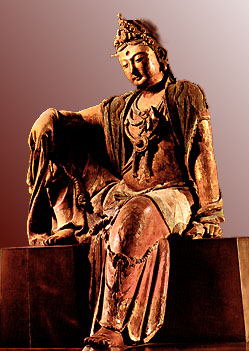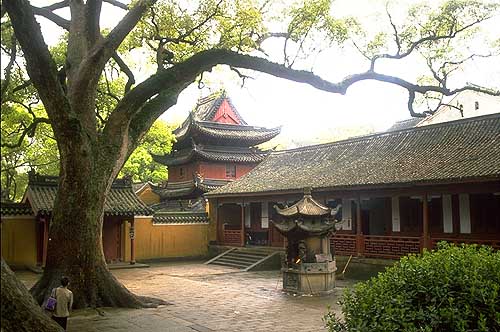Avalokitesvara
|
Avalokitesvara is possibly the most popular of all Buddhist deities, beloved throughout the Buddhist world. The word avalokita means “observes the sounds of the world” and isvara means “lord”. The full name has been variously interpreted as “the lord who hears/looks in every direction” and “the lord of hearing the deepest”. The great vow of Avalokitesvara is to listen to the supplications from those in difficulty in the world and to postpone his own Buddhahood until he has helped every being on earth achieving enlightenment. Therefore, he is treated as the embodiment of all the Buddhas' compassion, the lord of infinite compassion in Mahayana Buddhism.
According to the Chinese Tantric (Mi-tsung) school from Tang Dynasty, Avalokitesvara’s ability to assume innumerable forms that has led to thirty-three major representations. The following nine representations are the most famous ones. Among them the first seven has later become the famous Seven Avalokitesvara in Japanese Tantric (Shingon) school: (1) Sahasrabhuja (Senju), the 1,000 armed figure; (2) Ekadasamuhka (Ju-ichi-men), the 11 faced with 2-or 4-handed figure; (3) Cintamani cakra (Nyo-i-rin), the seated figure, with 6 arms, holding the wish-fulfilling jewel. (4) Amoghapasa (Fuku-kenjaku), the one with lasso and net, a form popular with the Tendai sect; (5) Hayagriva (Ba-to), the one with a fierce face and a horse's head in the hairdress; (6) Cundi (Jun-tei), the seated figure with 18 arms, the mother goddess; (7) Aryavalokitesvara (Sho), the sacred, simple form; (8) Palasambari (Ye-I), the one with leaf clothes, with 2 or 4 arms; (9) Pandurarasini (Bai-I), the one with white clothes, with 2 arms;
Avalokitesvara's worship was introduced into China (as Kuan-yin)
as early as the 1st century AD. Representations of
the bodhisattva in China prior to the Sung dynasty (960–1126) were masculine in
appearance. Later images displayed attributes of both genders is believed to be
accordance with the Lotus Sutra where Avalokitesvara has the ability of
assuming whatever form is required to relieve suffering and also has the power
to grant children. Also because this bodhisattva is considered a
mother-goddess, the representation in China has further interpreted in all
female form around the 12th century. However soft contours of the body seen in
statues and paintings have been intentionally combined with a visible moustache
to emphasize the absence of sexual identity. The sacred site of Kuan-yin is the
island of Pu-To (Mountain) near Ning-Po City (associated with the traditional
mountain residence of the bodhisattva Potala).
Kuan-yin's worship probably reached Japan (called Kannon) by way of Korea soon after Buddhism was first introduced into the country from the mid-7th century. The worship of the bodhisattva was never confined to any one sect and continues to be widespread throughout Japan. This bodhisattva was introduced into Tibet (called Chenresig- With a Pitying Look) in the 7th century, where he quickly became the most popular figure and successively reincarnated in each Dalai Lama. The most famous Tibetan mantras - om mani padmehum, translated as “the jewel in the lotus”, is credited with Avalokitesvara’s introduction to Tibet. In Tibet his images are frequently placed on hilltops. In Mongolia Avalokitesvara is called Nidü-ber üjegci (He Who Looks With the Eyes). The title used for him in Indochina and Thailand is Lokesvara (Lord of the World). |
 Avalokitesvara is also an emanation of Amitabha’s
compassion and with Amitabha’s figure represented in his headdress. He guards
the world in the interval between the departure of the historical Buddha, Sakyamuni, and the appearance of the
future Buddha, Maitreya. Based on scriptures of the Pure Land school that were
translated into Chinese between the 3rd and 5th centuries, the Pure Land sect
practitioner look to rebirth in the Western Paradise of the Buddha Amitabha,
Avalokitesvara forms part of a ruling triad, along with Amitabha and the
bodhisattva Mahasthamaprapta. Images of the three are often placed together in
temples.
Avalokitesvara is also an emanation of Amitabha’s
compassion and with Amitabha’s figure represented in his headdress. He guards
the world in the interval between the departure of the historical Buddha, Sakyamuni, and the appearance of the
future Buddha, Maitreya. Based on scriptures of the Pure Land school that were
translated into Chinese between the 3rd and 5th centuries, the Pure Land sect
practitioner look to rebirth in the Western Paradise of the Buddha Amitabha,
Avalokitesvara forms part of a ruling triad, along with Amitabha and the
bodhisattva Mahasthamaprapta. Images of the three are often placed together in
temples.